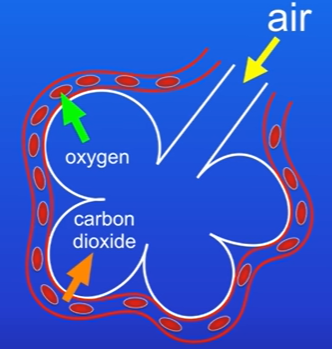GCSE Biology Revision "Gas Exchange in the Lungs"
Gas Exchange in the Lungs
Overview of the Respiratory System
Blood is pumped from the heart to the lungs to collect oxygen.
Oxygen is then delivered to body cells by the circulatory system.
Structure of the Lungs
Humans have two lungs.
Air enters through the tube ‘trachea’ which contains rings of cartilage to prevent collapse of trachea during inhalation.
The trachea splits into bronchi, which further divide into bronchioles.
The bronchioles end in tiny air sacs called alveoli where gas exchange occurs.

Alveoli and Gas Exchange
Alveoli are microscopic structures that allow the exchange of gases. Where gases diffuse in and out of the bloodstream(sites of gas exchange)
Gas Exchange Process:
Oxygen diffuses from the air into the bloodstream.
Carbon dioxide diffuses from the bloodstream back into the air.

Adaptations of Alveoli for Gas Exchange
1. Large Surface Area
Millions of alveoli provide a huge surface area for gas exchange.
2. Thin Walls
Alveoli have very thin walls, making a short diffusion path for gases.
3. Good Blood Supply
Once the oxygen diffuses into the blood, it's rapidly removed. ensuring that oxygen is rapidly transported away after diffusion.
This maintains a steep concentration gradient for efficient gas exchange.
4. Role of Breathing
Breathing helps increase the rate of diffusion by:
Bringing fresh oxygen into the alveoli.
Removing carbon dioxide.
This action sustains high concentration gradients for both gases, increasing rate of diffusion.